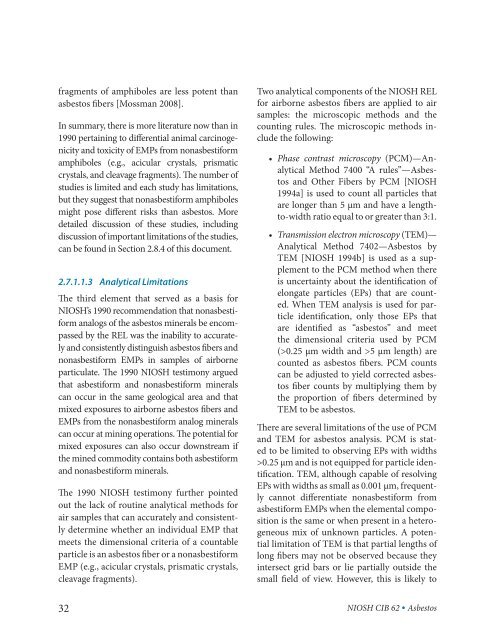Asbestos Fibers and Other Elongate Mineral Particles: State of the ...
Asbestos Fibers and Other Elongate Mineral Particles: State of the ...
Asbestos Fibers and Other Elongate Mineral Particles: State of the ...
- No tags were found...
Create successful ePaper yourself
Turn your PDF publications into a flip-book with our unique Google optimized e-Paper software.
fragments <strong>of</strong> amphiboles are less potent than<br />
asbestos fibers [Mossman 2008].<br />
In summary, <strong>the</strong>re is more literature now than in<br />
1990 pertaining to differential animal carcinogenicity<br />
<strong>and</strong> toxicity <strong>of</strong> EMPs from nonasbestiform<br />
amphiboles (e.g., acicular crystals, prismatic<br />
crys tals, <strong>and</strong> cleavage fragments). The number <strong>of</strong><br />
studies is limited <strong>and</strong> each study has limitations,<br />
but <strong>the</strong>y suggest that nonasbestiform amphiboles<br />
might pose different risks than asbestos. More<br />
detailed discussion <strong>of</strong> <strong>the</strong>se studies, including<br />
discussion <strong>of</strong> important limitations <strong>of</strong> <strong>the</strong> studies,<br />
can be found in Section 2.8.4 <strong>of</strong> this document.<br />
2.7.1.1.3 Analytical Limitations<br />
The third element that served as a basis for<br />
NIOSH’s 1990 recommendation that non asbestiform<br />
analogs <strong>of</strong> <strong>the</strong> asbestos minerals be encompassed<br />
by <strong>the</strong> REL was <strong>the</strong> inability to accurately<br />
<strong>and</strong> consistently distinguish asbestos fibers <strong>and</strong><br />
nonasbestiform EMPs in samples <strong>of</strong> airborne<br />
particulate. The 1990 NIOSH testimony argued<br />
that asbestiform <strong>and</strong> nonasbestiform minerals<br />
can occur in <strong>the</strong> same geological area <strong>and</strong> that<br />
mixed exposures to airborne asbestos fibers <strong>and</strong><br />
EMPs from <strong>the</strong> nonasbestiform analog minerals<br />
can occur at mining operations. The potential for<br />
mixed exposures can also occur downstream if<br />
<strong>the</strong> mined commodity contains both asbestiform<br />
<strong>and</strong> nonasbestiform minerals.<br />
The 1990 NIOSH testimony fur<strong>the</strong>r pointed<br />
out <strong>the</strong> lack <strong>of</strong> routine analytical methods for<br />
air samples that can accurately <strong>and</strong> consistently<br />
determine whe<strong>the</strong>r an individual EMP that<br />
meets <strong>the</strong> dimensional criteria <strong>of</strong> a countable<br />
particle is an asbestos fiber or a nonasbestiform<br />
EMP (e.g., acicular crystals, prismatic crystals,<br />
cleavage fragments).<br />
32<br />
Two analytical components <strong>of</strong> <strong>the</strong> NIOSH REL<br />
for airborne asbestos fibers are applied to air<br />
samples: <strong>the</strong> microscopic methods <strong>and</strong> <strong>the</strong><br />
counting rules. The microscopic methods include<br />
<strong>the</strong> following:<br />
• Phase contrast microscopy (PCM)—Analytical<br />
Method 7400 “A rules”—<strong>Asbestos</strong><br />
<strong>and</strong> <strong>O<strong>the</strong>r</strong> <strong>Fibers</strong> by PCM [NIOSH<br />
1994a] is used to count all particles that<br />
are longer than 5 µm <strong>and</strong> have a lengthto-width<br />
ratio equal to or greater than 3:1.<br />
• Transmission electron microscopy (TEM)—<br />
Analytical Method 7402—<strong>Asbestos</strong> by<br />
TEM [NIOSH 1994b] is used as a supplement<br />
to <strong>the</strong> PCM method when <strong>the</strong>re<br />
is uncertainty about <strong>the</strong> identification <strong>of</strong><br />
elongate particles (EPs) that are counted.<br />
When TEM analysis is used for particle<br />
identification, only those EPs that<br />
are identified as “asbestos” <strong>and</strong> meet<br />
<strong>the</strong> dimensional criteria used by PCM<br />
(>0.25 µm width <strong>and</strong> >5 µm length) are<br />
counted as asbestos fibers. PCM counts<br />
can be adjusted to yield corrected asbestos<br />
fiber counts by multiplying <strong>the</strong>m by<br />
<strong>the</strong> proportion <strong>of</strong> fibers determined by<br />
TEM to be asbestos.<br />
There are several limitations <strong>of</strong> <strong>the</strong> use <strong>of</strong> PCM<br />
<strong>and</strong> TEM for asbestos analysis. PCM is stated<br />
to be limited to observing EPs with widths<br />
>0.25 µm <strong>and</strong> is not equipped for particle identification.<br />
TEM, although capable <strong>of</strong> resolving<br />
EPs with widths as small as 0.001 µm, frequently<br />
cannot differentiate nonasbestiform from<br />
asbestiform EMPs when <strong>the</strong> elemental composition<br />
is <strong>the</strong> same or when present in a heterogeneous<br />
mix <strong>of</strong> unknown particles. A potential<br />
limitation <strong>of</strong> TEM is that partial lengths <strong>of</strong><br />
long fibers may not be observed because <strong>the</strong>y<br />
intersect grid bars or lie partially outside <strong>the</strong><br />
small field <strong>of</strong> view. However, this is likely to<br />
NIOSH CIB 62 • <strong>Asbestos</strong>

















